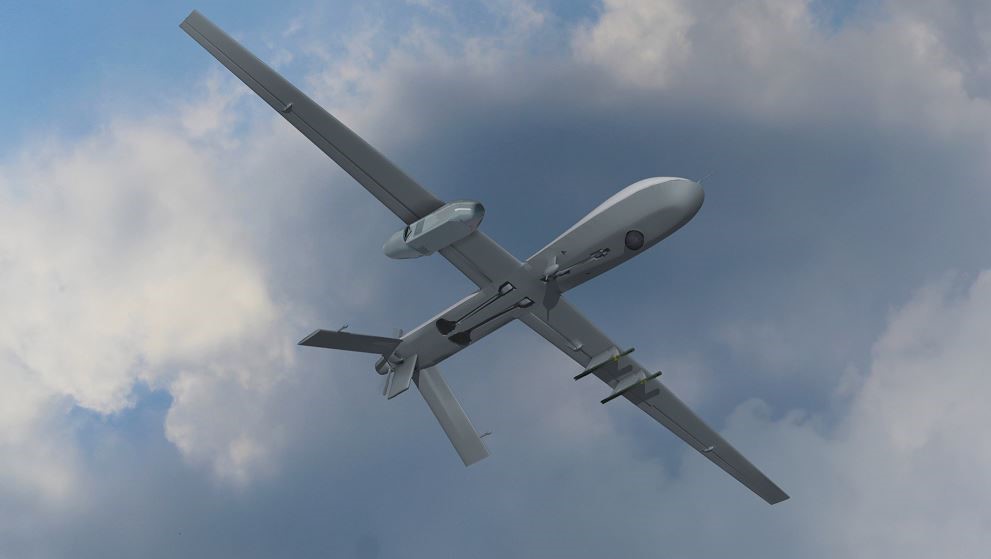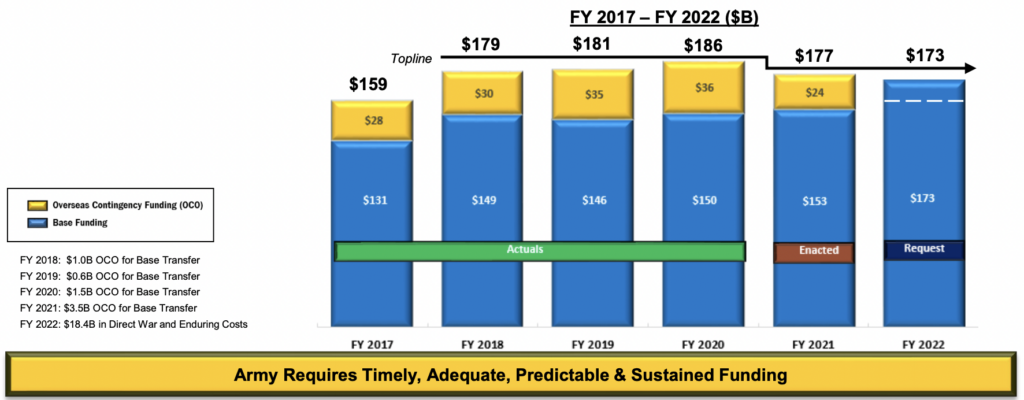
Lockheed Martin’s Silent Crow cyber/electronic warfare pod on an Army MQ-1C Grey Eagle drone. Silent Crow is the basis for MFEW-Air-Large (Lockheed illustration)
WASHINGTON: While protecting its top-priority weapons programs, the Army will buy fewer helicopters, upgrade fewer Abrams tanks, and zero out production of the long-awaited MFEW jamming pod.
For the overall budget, the Army has fallen back on old habits in tough budgetary times, cutting long-term modernization to protect near-term readiness and endstrength.
“We have a lot of people programs and we tried to protect those. Secondly, we tried to protect readiness,” acting secretary John Whitley told reporters at an embargoed roundtable. “Third, we tried to protect modernization.”
(The roundtable took place before Christine Wormuth was confirmed as Secretary on Thursday).

The Army’s overall budget, flat for years, is now dropping slightly with the withdrawal from Afghanistan.
Steeper cuts are expected next year, with the Army widely expected to be the big billpayer for a large boost in Navy shipbuilding. The Army Chief of Staff, Gen. James McConville, warned reporters at the roundtable: “Every one of our accounts is definitely pressurized, and if there are any further cuts, it will definitely result in us relooking really our entire budget strategy.”
Overall, the Army budget request is down $3.6 billion from what was enacted last year, dropping from $176.6B to $173. (That includes estimated costs for Afghanistan and other combat operations, formerly known as Overseas Contingency Operations funding). While the size of the force remains the same at 485,000 active-duty regulars, total military personnel funding actually rises by $1.2 billion, in keeping with McConville’s mantra of “people first.” Operations & maintenance dip slightly, by $0.7 billion. Procurement and R&D drop by $4.2 billion.
The service did protect its 35 top-priority programs, as promised, and even accelerates fielding of what will now be three full batteries of hypersonic missiles over the coming years. It also spent $4.4 billion on other programs deemed “crucial enablers” for the top 35. And the service’s new series of experimental wargames, Project Convergence, get a formal budget line for the first time: $106.8 million. But the Army made plenty of cuts elsewhere.
“We’re buying less Apache remans [remanufactured aircraft]. We’re buying less Black Hawks. We’re buying less Chinooks,” Lt. Gen. Thomas A. Horlander, a senior budgeteer, told reporters. “The Abrams line is going to be reduced as well.”
Perhaps the most painful chop: $12.3 million from Multi-Function Electronic Warfare (MFEW), zeroing production of the long-awaited jamming pod. The Army largely disbanded its electronic warfare force after the Cold War while Russia and China built lots of powerful jammers – but offensive EW was never included in the service’s top 35 priority programs.
MFEW, also called MFEW-Air-Large, is a pod for Grey Eagle drones. The Army’s also working on a land-based jammer, the Terrestrial Layer System, but currently it has only a handful of offensive jammers of any kind. (The service has plenty of short-range defensive jammers designed to disarm roadside bombs).
“This is the first time that we’ve had airborne capability like this,” Army electronic warfare program manager Col. Kevin Finch told the recent AOC CEMA conference. The MFEW prototype recently performed well during the EDGE 21 wargames, he said, where a major goal was “just giving it visibility for senior leaders… as we make budget decisions in the ’23 cycle and on.”
The budget plan does hold out some hope that MFEW procurement can get back into the budget. “Procurement of this program was cancelled; however, the Army continues Electronic Warfare R&D on next generation capabilities,” ran an Army statement to reporters. “Once the Multi-Functional Electronic Warfare Program successfully completes developmental testing, the program can re-compete for procurement funding in future budgets.”
Army 2022 Budget Terminations by Sydney Freedberg on Scribd
Other cancelled procurements weren’t offered the same chance of reprieve. They run from an aging night vision system – more modern models are being bought instead – to the Spider network-controlled mine. All told, the cuts save just $47.8 million, one quarter of it from MFEW. Reductions in 37 other programs that were not terminated freed up another $1.6 billion.
After years of ruthlessly pruning its budget to free up funds for the 35 top-priority programs, the Army’s reached diminishing returns, said acting secretary Whitley. “It is getting progressively harder to find lower-priority programs to realign,” he told reporters.
In the first round of so-called “night court” cuts, Whitley explained, the Army moved $22.4 billion over the five-year budget plan (for 2020-2024), eliminating 93 programs and reducing 93 others. In the second round, it moved $13.5 billion (over 2021-2025), eliminating 41 programs and reducing 39. In this third round, it moved $9.1 billion (over 2022-2026), eliminating just seven programs and reducing 37.
“The big fish are fished out of the pond,” Horlander put it.
Forget about finding low-hanging fruit, added the Chief of Staff, Gen. James McConville. “The fruit is mostly picked,” he said. “In fact, the tree’s almost gone.”
Of course, McConville noted, “there are other people that actually get votes on what stays” – namely Congress. For instance, the 2022 request doesn’t include any CH-47F Block II Chook helicopters (although it does buy the MH-47G model), but they will likely be in McConville’s congressionally mandated list of “Unfunded Requirements.” The last time the Army tried to cut back the CH-47F, Congress appropriated funds to buy five anyway. The service is still working on the production contract with Boeing, which has struggled to build the new rotor blades needed.






















